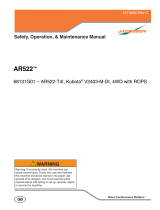
20 ENGLISH
8. Ensure that ramps are clean, strong and
secure. In order to reduce the risk of injury, all
ramps must be clear of loose debris and strong
enough to withstand the weight of anticipated
loads that will be moved over them. They must
have adequate blocking underneath and to both
sides to eliminate deections and side-to-side
movement under load. All ramps must be wide
enough to have sure footing while hauling loads
across them.
9. Ensure all locking screws are tightly secure
before using. Locking screws on the rear wheels
and open-type carrier front and side walls must be
secure to prevent unwanted movement of these
adjustable parts of the machine.
10. Never operate the machine in an overloaded
condition. Make sure the machine has the proper
capacity rating for the objects or materials that
have to be hauled. Excessive loads will make
the machine more dicult to maneuver and stop,
will increase stopping time and distance, and will
increase the risk of instability.
11. Never operate your machine in an over stacked
condition. Stacking material above the tray rim or
over the sides of the tray can cause the machine
to be uncontrollably out of balance and control.
12. Use containers and tie-downs to secure loads.
Loose and/or insecure loads are more likely
to shift which can result in loss of stability and
control.
13. Always maintain a rm grip on handles. Loss of
control can increase the risk of personal injury.
14. Remove safety key when not in use. The safety
key prevents unwanted, powered use of the
machine, such as by children or other untrained
or unauthorized persons. Without the key, electric
power cannot be turned “on”.
15. This machine cannot be used on public roads.
Use of the wheelbarrow on a public road is unlaw-
ful and could result in local jurisdiction penalties in
addition it could result in personal injury.
16. Use a sturdy plate with anti-slip and detach-
ment prevention function when loading and/
or unloading this machine for transportation,
or moving this machine between dierent
levels. Make sure the plate inclination does not
exceed 12°, and operate the machine slowly
and carefully. Unstable and quick operation
may result in overturn and/or falling.
17. Do not disassemble, repair, or modify this
machine.
Preparation
1. Before operating the machine, make sure that
there are no people around the machine.
2. Before operating the machine, perform
the inspections referring to the section for
maintenance.
Operation
1. When operating the machine, stand behind the
machine and hold the handles with both hands
rmly.
2. Do not operate the machine while riding on the
machine.
3. Do not allow others to ride on the machine.
4. When operating the machine in reverse and
walking backward, watch behind you and
watch your step, and be careful not to slip or
trip.
5. Do not use the machine when visibility is poor
because there is a risk of striking obstacles.
6. When operating the machine on rough ground
or going over the level dierence of the road,
decrease speed and exercise caution.
7. When using the machine, avoid soft ground
to prevent overturn due to the shoulder of the
road collapsing.
8. Do not operate the machine on upward slopes
greater than 12°.
9. If you nd an abnormality, stop the machine
on at ground. Before inspecting the machine,
lock the brake lever, and then turn the power
o.
10. Before operating the machine, make sure that
the handle of the dump unit is fully pulled
down and completely locked. If the lock is
incomplete, there is a risk of accident or injury as
the carrier or bucket may be tilted and the objects
fall when going downhill.
11. When operating the machine near walls, be
careful not to get your hands caught between
the handle and the wall.
12. Do not use the machine in bad weather condi-
tions, especially when there is a risk of light-
ning. This decreases the risk of being struck by
lightning.
13. Do not touch the metal parts during use or
after use as they may get hot enough to cause
burns due to sunlight.
14. Be careful not to entangle the cords with the
load or obstacles.
15. When crossing a wooden bridge, etc., make
sure that the sum of the weight of product,
load capacity, and operator's weight does
not exceed the weight limit of the bridge, and
cross the bridge carefully at a constant speed.
16. Wear the gloves when operating the machine
in low temperature environments. Touching
the metal parts with bare hands may cause your
hands to stick.
17. If there are people or obstacles in the direction
of travel, avoid them in advance.
18. Do not scoop objects directly with the carrier
or bucket. Doing so may damage the machine
and cause an accident.
19. When you use the machine on muddy ground,
wet slope, or slippery place, pay attention to
your footing.
20. Do not submerge the machine into a puddle.
Operation on slopes
1. Do not cross on slopes.
2. Stop before the downhill, and be sure to
decrease speed and exercise caution.
3. If the speed is too fast when traveling downhill,
the beep sound is emitted. In this case, slow
down using the brake.
4. Exercise caution when starting or stopping the
machine on slopes.




















 Jacobsen 68131G01 Omaniku manuaal
Jacobsen 68131G01 Omaniku manuaal
 MUUT-TUOTEMERKIT ESP307 Kasutusjuhend
MUUT-TUOTEMERKIT ESP307 Kasutusjuhend